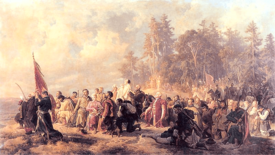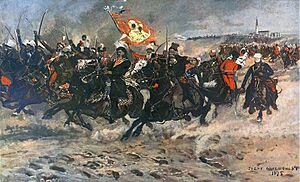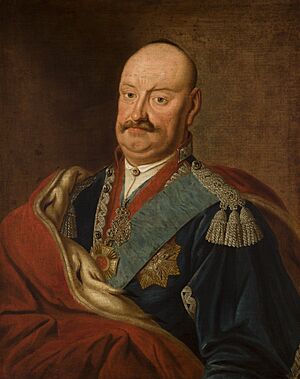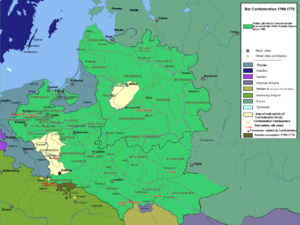Bar Confederation facts for kids
The Bar Confederation (Polish: Konfederacja barska) was a group of Polish and Lithuanian nobles, called szlachta, who came together in 1768. They formed this group at a fortress called Bar in a region known as Podolia (which is now part of Ukraine). Their main goal was to protect the independence of the Polish–Lithuanian Commonwealth from the strong influence of the Russian Empire.
They also opposed their own king, Stanislaus II Augustus, and other Polish reformers. These reformers were trying to limit the power of the very rich nobles, known as magnates. Important people who started the Bar Confederation included Adam Stanisław Krasiński, Karol Stanisław Radziwiłł, and Casimir Pulaski. This confederation led to a civil war in Poland and eventually played a part in the First Partition of Poland, where parts of Poland were taken by other countries. Some historians even call the Bar Confederation the first Polish uprising for independence.
Quick facts for kids War of the Bar Confederation |
|||||||||
|---|---|---|---|---|---|---|---|---|---|
| Part of the Russo-Polish wars | |||||||||
 Bar Confederates pray before the battle of Lanckorona, painting by Artur Grottger (1863) |
|||||||||
|
|||||||||
| Belligerents | |||||||||
(Bar Confederation) |
|||||||||
| Commanders and leaders | |||||||||
| Strength | |||||||||
| Lanckorona: 3,500 troops | Lanckorona: ~3,500 troops; 2 cannons Total: ~100,000 – 150,000 |
||||||||
| Casualties and losses | |||||||||
| Unknown | Heavy | ||||||||
Contents
Why the Bar Confederation Started
Russia's Growing Power
After the Seven Years' War ended in 1763, Russia became very powerful. Russia and Prussia signed a new agreement in 1764. They decided who would be the next king of Poland. They chose Stanislaus Poniatowski. He had been a friend of the Russian Empress, Catherine II of Russia. Neither France nor Austria could stop this choice. Stanislaus became king in October 1764.
Problems in Poland
By the 1700s, the Polish–Lithuanian Commonwealth was no longer a strong European power. It had become like a "satellite state" of Russia. This meant Russia had a lot of control over Poland's government. The Russian ruler often chose Poland's kings during the "free elections." Russia also decided many of Poland's internal rules.
For example, during the Repnin Sejm (1767–1768), the Polish parliament was forced to pass laws that Russia wanted. Many conservative nobles were angry about this foreign control. They felt the government under King Stanislaus Augustus was too weak. They also disliked new laws that gave more rights to non-Catholics. These nobles felt their traditional "Golden Liberty" was being threatened. Golden Liberty was a special set of rights and freedoms for the Polish nobility.

Russia's control became official with a treaty signed in February 1768. This treaty was called the "Treaty of perpetual friendship between Russia and the Commonwealth." The Polish parliament had to accept it without discussion.
The Confederation Begins (1768)
Because of Russia's strong influence, a group of Polish nobles decided to act. They were especially angry after Russian troops arrested some outspoken opponents. These included important bishops and a military leader. So, on February 29, 1768, these nobles formed a confederatio. This was a military group that opposed the government, which was allowed by Polish traditions. They signed their agreement at the fortress of Bar in Podolia.
Key leaders of this new confederation included Adam Krasiński, Casimir Pulaski, and Michał Jan Pac. A priest named Marek Jandołowicz was also an important religious leader for the group.
Civil War and Outside Help

The Bar Confederation declared war on Russia. They were encouraged and helped by Catholic France and Austria. Their army was made up of volunteers, private armies of nobles, and soldiers who left the royal army. They soon fought against Russian troops and Polish units loyal to the king.
Early Fights (1768)
Confederation forces, led by people like Michał Jan Pac and Prince Karol Stanisław Radziwiłł, moved across the country. They won some battles against the Russians. They even sent their own messengers to powerful European countries. The Ottoman Empire became their main ally.
King Stanislaus Augustus first tried to make peace between the Confederates and Russia. But when that didn't work, he sent his own army to fight them. The Ukrainian campaign lasted from April to June 1768. It ended when the city of Bar was captured on June 20. The Confederation forces had to retreat to Moldavia. There were also fights in other parts of Poland, but royal forces eventually took control of cities like Kraków.
At the same time, a peasant uprising called the Koliivshchyna broke out in Ukraine. This made some major Confederation forces move to the Ottoman Empire, which helped the Confederation survive. The Confederates asked for help from other countries. Their actions even helped start a war between Russia and the Ottoman Empire in September.
Continued Struggle (1769–1770)
Some Russian forces had to leave Poland to fight the Ottomans. This helped the Confederates, who became strong again in 1769. In 1770, the Bar Confederation's leaders moved their base to Hungary. From there, they talked with France, Austria, and Turkey to form an alliance against Russia. They even declared that the Polish king was no longer in power on October 22, 1770.
The French court sent a general named Charles François Dumouriez to help the Confederates. He helped them organize their army. He also strengthened several fortresses around Kraków, like Tyniec and Częstochowa.
The Confederates also started fighting in Lithuania. But after some early wins, they faced defeats there too. By early 1770, they were mostly on the defensive.
In November 1771, some Bar Confederates, including Casimir Pulaski, tried to kidnap King Stanislaus II Augustus. This event made Austria stop supporting the Confederates. It also gave Russia, Prussia, and Austria an excuse to say that Poland was chaotic. They claimed they needed to step in and "save" the country. After this, the king sided with Russia, and the Confederation lost much of its support in Europe.
The End of the Fight (1771–1772)
Even after losing support, the Confederation's army kept fighting. But 1771 brought more defeats. The final major battle was the siege of Jasna Góra, which fell in August 1772. Many fortresses held out as long as they could. Wawel Castle in Kraków fell in April, and Częstochowa, defended by Casimir Pulaski, held out until August.
Overall, about 100,000 nobles took part in 500 battles between 1768 and 1772. The last stronghold of the Confederates fell in November 1772. In the end, the Bar Confederation was defeated. Its members either fled to other countries or were sent to Siberia by the Russians. About 5,000 former Confederates were sent there.
While the war was happening, Austria and Prussia had already started taking some Polish border territories. In February 1772, an agreement to divide Poland was signed in Vienna. Russian, Prussian, and Austrian troops then occupied the areas they had agreed to take. On August 5, these three countries officially announced their territorial gains from Poland.
What Happened Next
By the mid-1700s, the balance of power in Europe was changing. Russia's wins against the Ottomans in their war made Russia even stronger. This worried Austria, which had interests in the same region. France suggested some land changes to keep the peace.
King Frederick II of Prussia didn't want to give up land he had recently gained. He wanted a peaceful solution. His alliance with Russia could pull him into a war with Austria. Prussia also wanted to protect the weakening Ottoman Empire, which could be useful if Prussia fought Russia or Austria.
Frederick's brother, Prince Henry, visited Saint Petersburg. He suggested that Prussia take some Polish land. Frederick then proposed that Austria, Prussia, and Russia all take parts of Poland. He wanted Russia to expand into weak Poland instead of the Ottoman Empire.
Russia had already seen Poland as its protectorate for decades. The civil war caused by the Bar Confederation, and a peasant uprising in Ukraine, further weakened Poland. Russia decided that Poland was no longer as useful as a protectorate. So, the three powers agreed to divide Poland. They said they were doing this to deal with a "troublesome neighbor" and bring order to Poland's "anarchy." All three countries wanted more land.
This led to the First Partition of Poland. Austria, Prussia, and Russia each took a piece of the Polish–Lithuanian Commonwealth.
The Confederation's Legacy
Before the Bar Confederation, groups like it that used outside help were often seen as disloyal. But after the Russian army marched through Poland and foreign powers forced Poland to agree to the First Partition, the Confederates started to be seen differently. They became an image of Polish soldiers who fought for their homeland, even if they had to go into exile. This idea later inspired groups like the Polish Legions.
Historians have different opinions about the Bar Confederation. Everyone agrees that they wanted to free Poland from outside (mostly Russian) control. Some historians, like Jacek Jędruch, criticize them for not being open to religious tolerance. They say this narrow view might have contributed to the First Partition. Others, like Bohdan Urbankowski, praise them as the first serious effort to regain Polish independence.
The Bar Confederation is often called the first Polish uprising. It is also remembered on the Tomb of the Unknown Soldier, Warsaw, with an inscription that says: "KONFEDERACJA BARSKA 29 II 1768 – 18 VII 1772".
See also
- Aleksandr Bibikov
- Anna Jabłonowska
- Józef Sawa-Caliński
- Jozef Miaczinsky
- Koliyivshchyna





